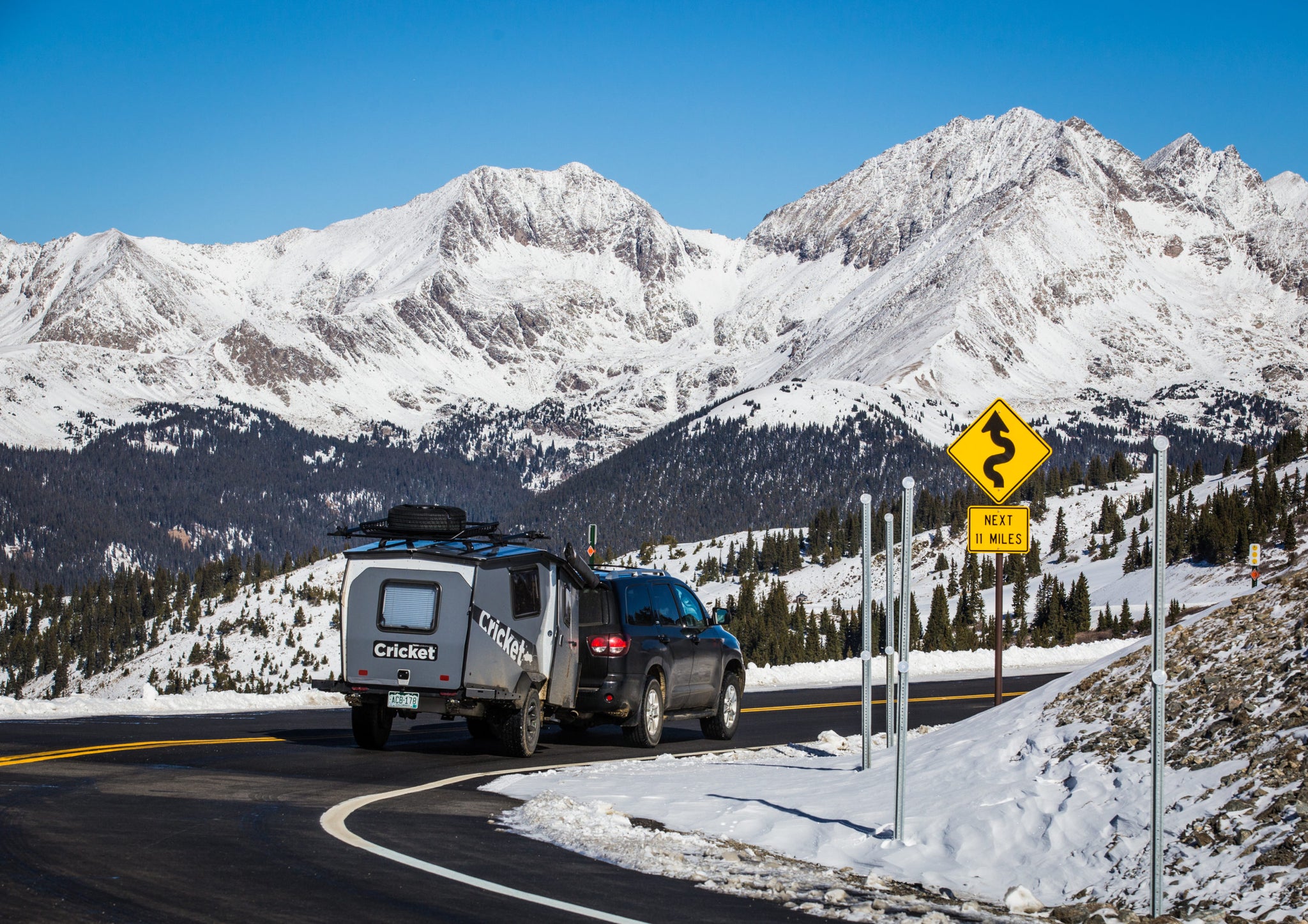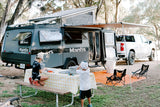Winter is upon us, and family vacations are in the mix. For many, this means strictly staying indoors, whether traveling is involved or not. Others seek to embrace the cold with the help of an adventure vehicle. With this in mind, there are some key measures to take when battling the cold in the wilderness, namely picking the right habitat in which to keep warm. Choosing the right vehicle for the family can be all the difference to not only their comfort, but how enthusiastically they interact with the outdoors. While your choice and criteria will be subject to your specific needs, here are some considerations to keep in mind when looking for a trailer for your next winter expedition.
What size vehicle makes the best winter camper?
Let’s start off with the foundation of your expedition, the vehicle itself. These types of trips with multiple people exploring the wilderness usually come down to two camps of people (no pun intended): Those who use a smaller RV, and those who use a travel trailer.
A class C RV is a type of motorhome defined by its middle ground in size between class A and B vehicles. Most class C’s merge a cutaway van chassis with the rest of the home. While typically not as luxurious as class A models, class C RVs are generally thought to be easier to maneuver, and a more economical option to boot.
On the other hand, people define travel trailers less by a specific size and more by how they are towed. Travel trailers require a hitch to attach to a car or truck. They have no mobile function on their own and as such, their characteristics vary wildly. For the sake of simplicity and comparison, we’ll be using the TAXA Mantis as a realistic travel trailer option that a family might use.
If you already have a TAXA and need to prepare it for the cold weather, check out our step-by-step guide for this process.
Space comparison
Obviously, adequate space is a requirement for any family outing. Kids and parents alike need personal space to keep spirits high. Not only that, but a robust footprint enables families to bring all the essentials to stay warm and play hard. Cold-weather items are generally bulky, so having enough storage for everything you need is important.
Class C RV:
- Sleeps 4 to 8 people
- Typically between 21 and 33′ long
- Between 1,000-1,500 of cargo capacity
Mantis Travel Trailer:
- Sleeps 4 comfortably, potential to add 3 or more with additions like a rooftop tent or bunkbed system
- 19′ long
- 1,028 cargo capacity
Heat capabilities
Maintaining a comfortable temperature indoors is essential to keeping the family charged up and ready to explore. While layering and having warm drinks on hand will play a role in this, the habitat itself will most likely do the heavy lifting. Power sourcing proves the most influential here, so you’ll need adequate power to keep the main furnace working while also fueling supplemental heat sources.
Class C RV:
- Electric or gas furnace depending on the model
- Battery-reliant electrical system
- 2-3 days of electrical capacity with multiple batteries and moderate use
Mantis Travel Trailer:
- Truma Combi Eco Furnace & Water Heater System
- Battery-powered electrical system, and many travel trailers (including Mantis) feature a solar-powered inlet
- 2-3 days of electrical capacity, potential for 7 plus days off-grid power with adequate sunlight for solar power
Family-friendly extras
Equally important, different vehicles flaunt different living amenities. Generally speaking, a class C RV and a larger-sized travel trailer should have at least the basics. Families need some way to make and store food and also require some method of bathing and using the restroom. Further, most vehicles include some space to interact and encourage social activity.
Class C RV:
- Internal wet bath
- Full galley kitchen
- Small living area with stationary furniture
Mantis Travel Trailer:
- Internal wet bath
- Full galley kitchen
- Small living area with modular furniture, convertible seating for 6
Rugged limitations
Another consideration for the differences between an RV and a travel trailer is their terrain limitations. A class C RV can visit traditional campsites, but many travel trailers like Mantis have much more robust suspension and impressive ground clearance to get to harder-to-reach spots. The Overland versions of our campers boast even higher clearance for more versatility and access. Due to these modifications, Mantis and its overland version can safely travel over much more rugged terrain than an RV, expanding the number of potential destinations your family can visit.
Drivability challenges
Some drivers might not feel safe or comfortable maneuvering a 30′ vehicle like a class C RV. While towing a trailer is also tricky, this arrangement allows you to at least drive from the comfort of your traditional vehicle.
Price difference
A class C RV typically ranges between $75,000 – $100,000. It also carries other potential expenses like storage costs or extra money spent on gas. A travel trailer represents one of the more reasonable price options in the family-sized recreational vehicle market. The TAXA Mantis, for example, retails at $46,000. It also fits in most 7′ garages and weighs in under 3,000 lbs, keeping fuel costs to a minimum.
Additional winter camper features to look for
As you can see, there are pros and cons to each of these common options and a decision will depend on your priorities and interests. However, there are a few features or factors that are necessary for winter adventures, no matter what vehicle you choose. These are features that you should look for when purchasing, or keep in mind to upgrade individually later.
Comprehensive heating system
Interior heating elements are essential for fighting off the cold while living in a travel trailer. While smaller plugin elements help a bit, a climate-controlled master furnace is essential for comfortable temperature regulation overnight. Interior kitchens also provide lots of heat for short periods of time and hold a distinct advantage over exterior pull-out kitchens.
For instance, TAXA’s Cricket and Mantis both boast interior kitchens as well as the Truma Eco Furnace & Water Heater System. The Truma runs on both gas and electric for a quick, efficient, and safe hybrid approach to heating a vehicle, so you never have to worry about going cold.

Reliable power supply
A consistent power supply is vital while exploring in cold climates. Even if certain heating elements on the vehicle run on gas, many of these still require some sort of electrical input to function correctly. Not to mention, supplementary accessories such as space heaters or pads absolutely need electrical power.
Thus, the best cold-weather travel trailer should have multiple solutions in place to keep electricity flowing, in case it’s overcast or you run out of propane. When it comes to TAXA’s offerings, all of our travel trailers come with pre-wired solar input and run on swappable batteries so you have peace of mind.

Plenty of storage
Staying warm is important while out in the cold. However, it’s far from everything — in fact, storage capacity is often a more critical factor in cold weather trips.
Just think about it. Low temperatures attract bulk. Coats, jackets, and blankets all take up more space than their warm-weather counterparts. Bringing along heaters or firewood only adds to the problem further. This also doesn’t account for any extra sporting equipment common among cold weather trips such as skis, snowboards, or helmets.
With that said, the best cold-weather travel trailers have a robust storage capacity. This provides explorers with adequate layering options as well as the opportunity to bring gear for specific activities if desired. If you’re considering our Mantis, it once again excels in this area. With over 1,000 lbs of cargo capacity and roof rack options for bulky items up top, there’s no shortage of space for getting everything comfortably packed.

Experience the outdoors without freezing
The best cold-weather travel trailers battle the cold through functionality. They equip explorers with multiple power solutions to keep all heating strategies operational and employ robust heating elements within the trailer itself. The vehicles also have plenty of room for any and all cargo necessities despite the bulk of cold-weather items.
We at TAXA prefer a functional approach to vehicle design, with our goal being to build thoughtful mobile habitats and other equipment that facilitate connections with nature. If a travel trailer ready for the outdoors (and equipped for snow or sun) sounds like what you’re looking for, our Mantis and Cricket campers might be everything you need and more. Both are spacious options with pop-up roofs, with plenty of features to keep you comfortable — but not too far away from nature. Talk to one of our habitat specialists today!


